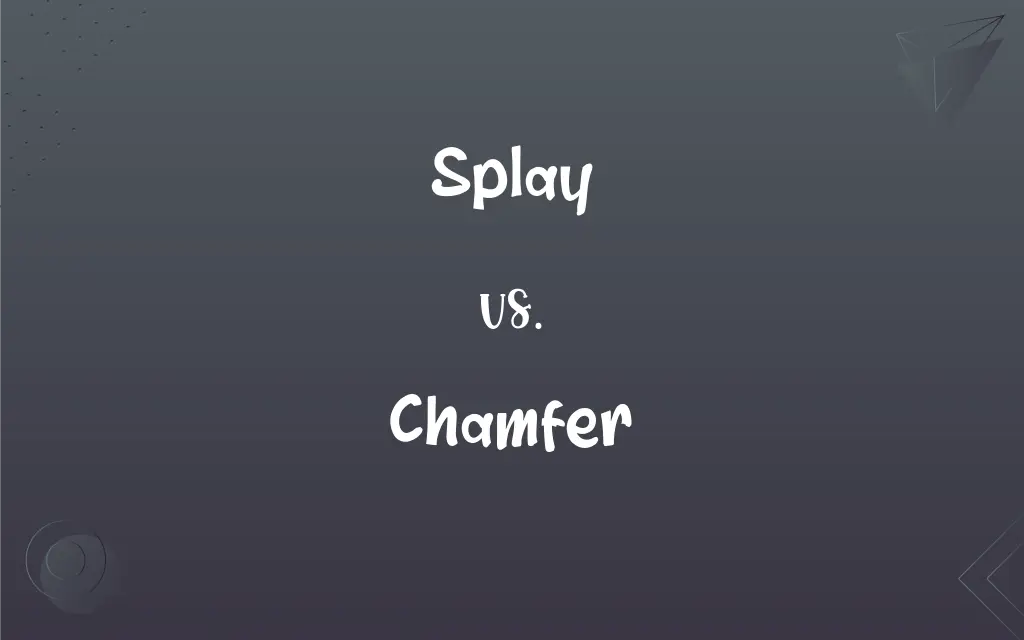Splay vs. Chamfer: What's the Difference?
By Janet White & Harlon Moss || Updated on May 22, 2024
Splay is a surface that is angled away from a main plane, typically widening outward, while chamfer is an angled cut or beveled edge that transitions between two surfaces, typically at 45 degrees.

Key Differences
Splay refers to a surface that spreads or flares outward at an angle from a primary plane. This term is often used in architecture and woodworking to describe openings, such as windows or doors, that widen outward from the inside to the outside, providing a broader view or more light. Chamfer, on the other hand, is a specific type of beveled edge that connects two surfaces by cutting off the sharp corner at an angle, usually 45 degrees. Chamfers are commonly used in carpentry, metalworking, and manufacturing to ease edges, prevent damage, or enhance the aesthetic appeal of an object.
Splays are typically broader and affect a larger surface area, creating a more dramatic visual effect. Chamfers are precise cuts that smooth out edges, often for practical reasons such as safety or fit.
While splaying is used to describe outward widening, often in openings or edges, chamfering specifically refers to creating a beveled edge to remove sharpness or improve joint fitting.
Comparison Chart
Definition
Angled surface widening outward
Beveled edge at an angle, typically 45 degrees
Application
Architecture, woodworking
Carpentry, metalworking, manufacturing
ADVERTISEMENT
Purpose
Enhance openness, light, view
Ease edges, prevent damage, aesthetic appeal
Visual Effect
Creates broader, flaring shapes
Smooths edges, reduces sharpness
Common Use
Window and door openings
Edges of furniture, mechanical parts
Splay and Chamfer Definitions
Splay
Surface angled outward from a main plane.
The window's splay allowed more sunlight to enter the room.
Chamfer
Beveled edge at an angle, typically 45 degrees.
The carpenter added a chamfer to the tabletop for a smooth finish.
ADVERTISEMENT
Splay
Common in architectural openings.
Splayed window frames are a hallmark of traditional architecture.
Chamfer
Used in carpentry, metalworking, and manufacturing.
The designer used chamfers to create sleek lines on the furniture.
Splay
To spread (the limbs, for example) out or apart
The dog rolled on its back and splayed its legs.
Chamfer
Precise cut to smooth or ease an edge.
Chamfering the edges of the metal sheet prevented injuries.
Splay
To make slanting or sloping; bevel
Splayed the edge of the tabletop.
Chamfer
Enhances the fit and safety of parts.
The mechanical part was chamfered to ensure a snug fit.
Splay
To dislocate (a bone). Used of an animal.
Chamfer
To cut off the edge or corner of; bevel.
Splay
To be spread out or apart
After work, he splayed out on the couch.
Chamfer
To cut a groove in; flute.
Splay
To slant or slope.
Chamfer
A flat surface made by cutting off the edge or corner of a block of wood or other material.
Splay
Spread or turned out.
Chamfer
A furrow or groove, as in a column.
Splay
Clumsy or clumsily formed; awkward.
Chamfer
An obtuse-angled relief or cut at an edge added for a finished appearance and to break sharp edges.
Splay
An oblique angle or bevel given to the sides of an opening in a wall so that the opening is wider on one side of the wall than on the other.
Chamfer
(transitive) To cut off the edge or corner of something.
Splay
To spread; spread out.
Chamfer
(transitive) To cut a groove in something.
Splay
To dislocate, as a shoulder bone.
Chamfer
The surface formed by cutting away the arris, or angle, formed by two faces of a piece of timber, stone, etc.
Splay
To turn on one side; to render oblique; to slope or slant, as the side of a door, window, etc.
Chamfer
To cut a furrow in, as in a column; to groove; to channel; to flute.
Splay
To rearrange (a splay tree) so that a desired element is placed at the root.
Chamfer
To make a chamfer on.
Splay
To spay; to castrate.
Chamfer
Two surfaces meeting at an angle different from 90 degrees
Splay
Spread out; turned outward.
To sit splay-legged
Chamfer
Cut a bevel on; shape to a bevel;
Bevel the surface
Splay
Flat and ungainly.
Splay shoulders
Chamfer
Cut a furrow into a columns
Splay
A slope or bevel, especially of the sides of a door or window, by which the opening is made larger at one face of the wall than at the other, or larger at each of the faces than it is between them.
Chamfer
Transition between two surfaces by cutting off a corner.
The chamfered edges of the shelf added to its modern aesthetic.
Splay
To display; to spread.
Splay
To dislocate, as a shoulder bone.
Splay
To spay; to castrate.
Splay
To turn on one side; to render oblique; to slope or slant, as the side of a door, window, etc.
Splay
Displayed; spread out; turned outward; hence, flat; ungainly; as, splay shoulders.
Sonwthing splay, something blunt-edged, unhandy, and infelicitous.
Splay
A slope or bevel, especially of the sides of a door or window, by which the opening is made larged at one face of the wall than at the other, or larger at each of the faces than it is between them.
Splay
An outward bevel around a door or window that makes it seem larger
Splay
Spread open or apart;
He splayed his huge hands over the table
Splay
Turn outward;
These birds can splay out their toes
Ballet dancers can rotate their legs out by 90 degrees
Splay
Move out of position;
Dislocate joints
The artificial hip joint luxated and had to be put back surgically
Splay
Turned outward in an ungainly manner;
Splay knees
Splay
Widening of an opening to enhance view or light.
The splayed edges of the doorway made the entrance appear grander.
Splay
Flaring outward at an angle.
The splayed design of the arch gave it a distinctive look.
Splay
Creates a sense of openness.
The splay in the wall design provided a broader perspective of the landscape.
FAQs
What is a splay in architecture?
A splay in architecture is an angled surface that widens outward, often seen in window and door openings.
Can splay be used in furniture design?
Yes, splay can be used in furniture design to create outward flaring shapes that enhance visual interest and openness.
What materials can be splayed?
Materials such as wood, stone, and metal can be splayed in various architectural and design applications.
Can both splay and chamfer be decorative?
Yes, both splay and chamfer can be used for decorative purposes, enhancing the visual appeal of structures and objects.
What is the purpose of a chamfer?
A chamfer is used to ease edges, prevent damage, and enhance the aesthetic appeal of objects by creating a beveled edge.
What tools are used to create a chamfer?
Tools such as chamfer bits, chisels, and specialized milling cutters are used to create chamfers.
How is a chamfer different from a bevel?
A chamfer specifically refers to a 45-degree cut at the edge of an object, while a bevel can be any angled cut along an edge.
Do chamfers require special skills to create?
Yes, creating chamfers typically requires precision and skill, especially in carpentry and metalworking.
What are the benefits of chamfering in manufacturing?
Chamfering improves safety by removing sharp edges and enhances the fit and finish of manufactured parts.
Where are chamfers commonly found?
Chamfers are commonly found on furniture edges, mechanical parts, and in construction elements to smooth edges and corners.
Can splaying be applied to interior design?
Yes, splaying can be applied to interior design to create interesting angles and improve the flow of spaces.
Is a splay angle always the same?
No, the angle of a splay can vary depending on the design requirements and intended effect.
Is a splay used for functional purposes?
Yes, splays can be used to increase light, enhance views, and create a sense of space in architectural designs.
What are common tools for creating splays?
Common tools for creating splays include saws, chisels, and specialized cutting tools depending on the material.
Can chamfers be added after initial construction?
Yes, chamfers can be added to edges after initial construction using appropriate tools.
What is the typical angle of a chamfer?
The typical angle of a chamfer is 45 degrees, although other angles can be used depending on the design requirements.
What is the difference between a chamfer and a fillet?
A chamfer is a beveled edge, while a fillet is a rounded edge, both used to smooth corners but with different shapes.
Are splays common in modern architecture?
Splays can be found in both traditional and modern architecture, often used to enhance light and views.
Can chamfers be used in metalworking?
Yes, chamfers are widely used in metalworking to remove sharp edges and improve the fit of components.
How does a splay affect the structure's appearance?
A splay can make a structure appear more open and spacious by widening openings and creating flared surfaces.
About Author
Written by
Janet WhiteJanet White has been an esteemed writer and blogger for Difference Wiki. Holding a Master's degree in Science and Medical Journalism from the prestigious Boston University, she has consistently demonstrated her expertise and passion for her field. When she's not immersed in her work, Janet relishes her time exercising, delving into a good book, and cherishing moments with friends and family.
Co-written by
Harlon MossHarlon is a seasoned quality moderator and accomplished content writer for Difference Wiki. An alumnus of the prestigious University of California, he earned his degree in Computer Science. Leveraging his academic background, Harlon brings a meticulous and informed perspective to his work, ensuring content accuracy and excellence.































































